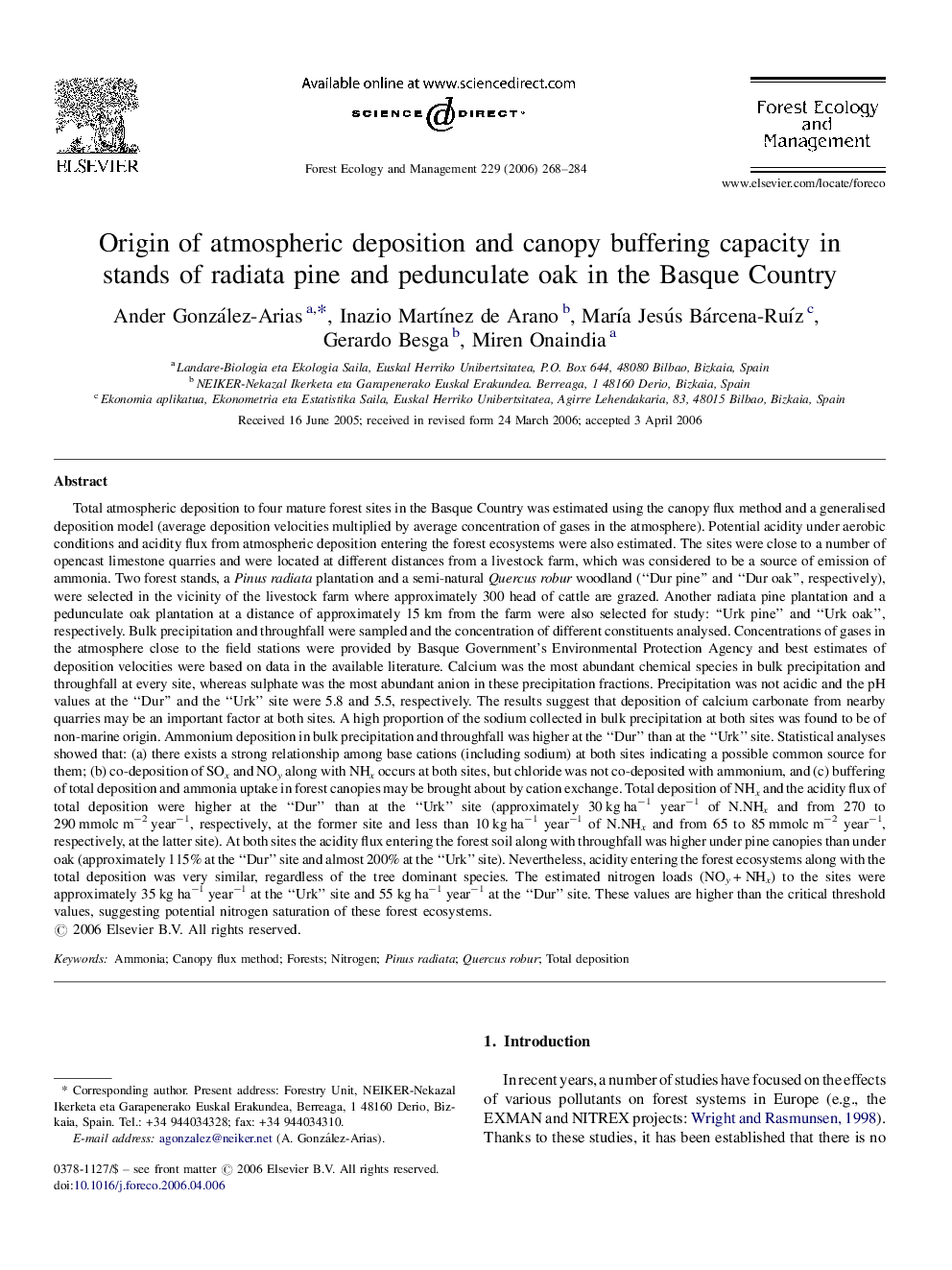| Article ID | Journal | Published Year | Pages | File Type |
|---|---|---|---|---|
| 90845 | Forest Ecology and Management | 2006 | 17 Pages |
Total atmospheric deposition to four mature forest sites in the Basque Country was estimated using the canopy flux method and a generalised deposition model (average deposition velocities multiplied by average concentration of gases in the atmosphere). Potential acidity under aerobic conditions and acidity flux from atmospheric deposition entering the forest ecosystems were also estimated. The sites were close to a number of opencast limestone quarries and were located at different distances from a livestock farm, which was considered to be a source of emission of ammonia. Two forest stands, a Pinus radiata plantation and a semi-natural Quercus robur woodland (“Dur pine” and “Dur oak”, respectively), were selected in the vicinity of the livestock farm where approximately 300 head of cattle are grazed. Another radiata pine plantation and a pedunculate oak plantation at a distance of approximately 15 km from the farm were also selected for study: “Urk pine” and “Urk oak”, respectively. Bulk precipitation and throughfall were sampled and the concentration of different constituents analysed. Concentrations of gases in the atmosphere close to the field stations were provided by Basque Government's Environmental Protection Agency and best estimates of deposition velocities were based on data in the available literature. Calcium was the most abundant chemical species in bulk precipitation and throughfall at every site, whereas sulphate was the most abundant anion in these precipitation fractions. Precipitation was not acidic and the pH values at the “Dur” and the “Urk” site were 5.8 and 5.5, respectively. The results suggest that deposition of calcium carbonate from nearby quarries may be an important factor at both sites. A high proportion of the sodium collected in bulk precipitation at both sites was found to be of non-marine origin. Ammonium deposition in bulk precipitation and throughfall was higher at the “Dur” than at the “Urk” site. Statistical analyses showed that: (a) there exists a strong relationship among base cations (including sodium) at both sites indicating a possible common source for them; (b) co-deposition of SOx and NOy along with NHx occurs at both sites, but chloride was not co-deposited with ammonium, and (c) buffering of total deposition and ammonia uptake in forest canopies may be brought about by cation exchange. Total deposition of NHx and the acidity flux of total deposition were higher at the “Dur” than at the “Urk” site (approximately 30 kg ha−1 year−1 of N.NHx and from 270 to 290 mmolc m−2 year−1, respectively, at the former site and less than 10 kg ha−1 year−1 of N.NHx and from 65 to 85 mmolc m−2 year−1, respectively, at the latter site). At both sites the acidity flux entering the forest soil along with throughfall was higher under pine canopies than under oak (approximately 115% at the “Dur” site and almost 200% at the “Urk” site). Nevertheless, acidity entering the forest ecosystems along with the total deposition was very similar, regardless of the tree dominant species. The estimated nitrogen loads (NOy + NHx) to the sites were approximately 35 kg ha−1 year−1 at the “Urk” site and 55 kg ha−1 year−1 at the “Dur” site. These values are higher than the critical threshold values, suggesting potential nitrogen saturation of these forest ecosystems.
